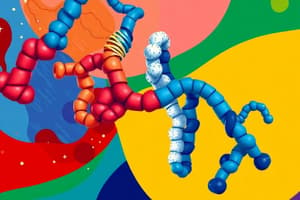Podcast
Questions and Answers
What makes the hydrogen-bonded sequences in β-pleated sheets stronger when they run antiparallel to adjacent elements?
What makes the hydrogen-bonded sequences in β-pleated sheets stronger when they run antiparallel to adjacent elements?
- N-H and C=O groups can line up as closely, strengthening the H-bonds.
- The structure becomes more unstable, leading to stronger interactions.
- Ionic bonds are formed between adjacent elements, increasing the hydrogen bond strength.
- The geometry is such that N-H and C=O groups can't line up closely, weakening the H-bonds. (correct)
Which type of bonds stabilize the tertiary structure of proteins?
Which type of bonds stabilize the tertiary structure of proteins?
- Hydrophobic bonds between R-groups (correct)
- Covalent bonds between N-H and C=O groups
- Van der Waals forces between R-groups
- Ionic bonds between N-H and C=O groups
What is the result of disrupting the four interactions that stabilize a protein's tertiary structure?
What is the result of disrupting the four interactions that stabilize a protein's tertiary structure?
- Increased activity of the protein
- Enhanced stability of the protein structure
- Formation of stronger hydrogen bonds
- Denaturation or unfolding of the protein (correct)
What type of interactions play a key role in creating the tertiary structure of proteins?
What type of interactions play a key role in creating the tertiary structure of proteins?
In the example of hemoglobin provided in the text, how many polypeptide subunits come together to form a complete, functional hemoglobin molecule?
In the example of hemoglobin provided in the text, how many polypeptide subunits come together to form a complete, functional hemoglobin molecule?
Where is the information to build the polypeptide subunits of hemoglobin found?
Where is the information to build the polypeptide subunits of hemoglobin found?
What defines a protein's primary structure?
What defines a protein's primary structure?
Which type of bond in a protein's structure exhibits characteristics of a double bond?
Which type of bond in a protein's structure exhibits characteristics of a double bond?
What do the polypeptide chains in a protein's structure lack flexibility due to?
What do the polypeptide chains in a protein's structure lack flexibility due to?
Which structural elements in proteins are formed without involving the R-groups?
Which structural elements in proteins are formed without involving the R-groups?
Flashcards are hidden until you start studying



